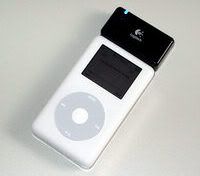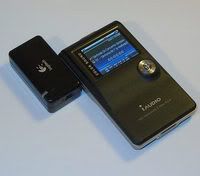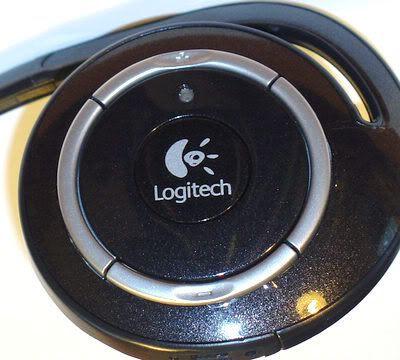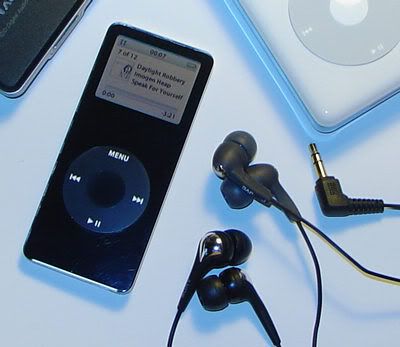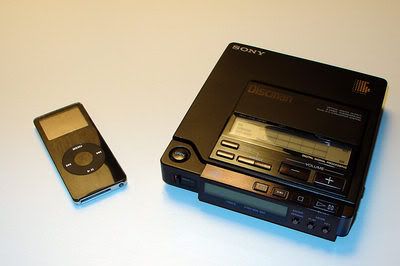I picked these up a while back as… well, they’re interesting, and usually that’s all that’s required for me to pick something up. I was not expecting a whole lot to be honest. My audio-based experiences of Bluetooth technology to date have not been, shall we say, stunning. The headphones retail for £99 in the UK and approximately $130 in the US.
The Logitech Bluetooth Headphones use the Bluetooth (duh) short-range digital transmission system to send audio to the headphone from the slightly bulky transmitter at a practical maximum of around 4 ~ 6m (12 ~ 18ft) range.
The headphones have built-in controls for volume, and the iPod-specific version also has track control / pause functions. As the iPod version has the remote socket built-in to the transmitter, it’s not compatible with non-iPod players nor the Nano / 5G. So I chose the regular “MP3” variety.
Charging up the non-replaceable Li-ion batteries in both headphone and transmitter takes around 3 hours, and pairing it is as simple as switching on the phones after the transmitter is on... and they’re ready to use.
I plug the transmitter into an iPod and am quite surprised at what comes out. It’s actually music as more or less it’s supposed to be played, not a frog chorus with the flu in an echo chamber!
The sound is comparable in general quality and tonal balance to the £30 Sennheiser PX100, although there is more 'enclosure honk', a sort of tin can effect overtone especially in the midrange. There’s a fairly solid bass, a mild top end and a midrange that doesn’t feel particularly boosted or recessed. Quite an agreeable tonal balance in general, but nowhere near a half-decent £99 wired headphone in terms of sound quality. Of course, I wasn't expecting that.
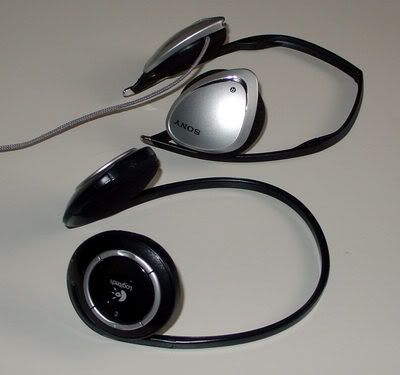
The Logitech phones compared to a Sony MDR-G74.
The general physical characteristic of the Logitech is comparable to other behind-the-neck headphones such as the Sony MDR-G74SL, only that it doesn’t fold. It’s the same sort of street style design, and unfortunately just as uncomfortable, tending to dig in at the top of the ear after a while. There’s also a convex curve to the phones where they meet the ear, and this means that placing of the phone on the ear is slightly more critical than your regular mini / street style phone. Shifting the phones around does create a change in the sound so it’s important to seat them properly. The increase in weight with the circuitry and batteries is definitely noticeable if you compare the Logitechs with a regular street style, but it's not a big deal when worn. The general lack of comfort though (like the Sonys) was more of a problem for me.
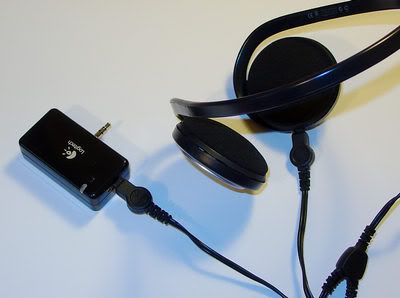
Charging the Logitech.
Battery life seems adequate for a commute. The maximum I’ve used the phones for between charges is 4 hours or so, although I'm sure they could have gone on longer (I haven't really tested the battery life). The claimed life is 8 hours on a charge. The phone and transmitter are charged by a ‘dual-head’ socketed AC charger.
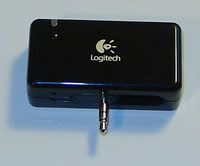
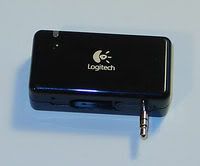
Transmitter headphone jack positionsThe transmitter is somewhat bulky, but it’s fairly lightweight. It also has a jack that locks into two different positions, so it works with a wide range of players. If the jack positioning isn’t optimal, there’s a low-profile extension cable supplied.
The range depends on whether there's anything between you and the transmitter. Either way, it's pretty clear whenyou're about to go out of range as the music starts breaking up... you get bursts of music with silence inbetween. Usually, I got about a 4m range with one plaster wall / wooden door inbetween.
In terms of sporting use, my jury’s out… although they’re stable while worn, the phones are noticeably heavier than a pair of lightweight earphones and even a pair of regular street styles, and sweat / Li-ion batteries can’t be a match made in heaven.
You certainly don’t get what you pay for in sonic terms, but what it does achieve is quite impressive. And as minor an inconvenience as it might seem to many, the lack of a cable is quite refreshing in use. It is a bit of a shame though that they chose to pattern the phones on an open, street-style chassis as it’s not particularly comfortable, and although open phones are safer for active use, I feel some isolation would have been nice for commuters in general.
Would you pay an effective 200% premium on top of a £30 headphone to get rid of the cable? If I was given a choice once again, probably not. But the wireless technology does work pretty well, and for some I would imagine the curiously satisfying sense of freedom is worth it.
Logitech Bluetooth Headphones: ~$130 (US), ~£99 (UK).
Product Link (Logitech USA)

